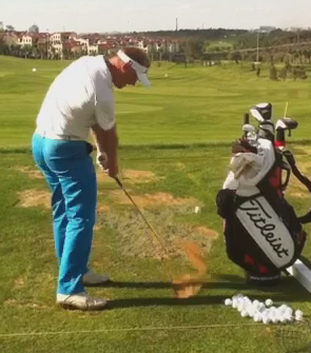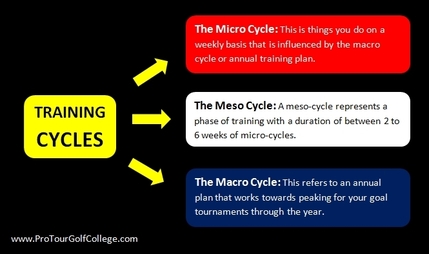How to Practice Golf: Developing an Annual Training and Performance Plan for Golf (Part 3)3/11/2012
 Your annual training and tournament plan is a critical part of your golf development process because it provides you with strategies that will guide you towards ideal performances at important times in your year. Your new plan begins after your last tournament of the year and ideally is developed after the last transition phase. In constructing your plan you can objectively evaluate your performances with your golf instructor/coach from a technical, psychological, strategic and physical point of view to determine the direction of your plan going forward. You will look for key performance indicators that have influenced performances in a positive or negative way in the previous year to determine what amendments and additions are added to the new plan. Your golf instructor/coach will use this data plus his/her observations of your performances both in training and in tournaments to determine the structure of the plan. The components that make up the golf training plan are not set in stone and need to be flexible enough to change direction as needed. They are guideline with a definite structure. Once you have obtained your tournament schedule (ideally not later than the last transition phase the previous year) for the next year you can sit down with your golf instructor/coach and decide which tournaments you wish to compete in and also decide on the key events you want to play your best in. At Pro Tour Golf College we use a training plan with 4 stages: 1. Golf Tournaments and Dates 2. Periodization 3. Golf Performance Objectives 4. Golf Training Factors We have found that this structure works well for managing our students golf performances both on the practice ground and also in tournaments. There are certainly more complex forms used in training plans that you could employ however we always leave the option open in our plans for adding additional elements as needed. Your plan will explain how you will approach improvement of your golf skills so that the result is a lower score average. This will mean that your annual plan is periodized into smaller more manageable chunks that will narrow your focus and encourage good practice. Last week we discussed training phases and sub phases within the macrocycle. Your training and tournament plan should describe the type of work you will perform within training cycles called mesocycles and microcycles.  The Mesocycle and Microcycle A mesocycle is a phase of training with a timeline of normally 2 to 6 weeks of microcycles. A microcycle is characteristically a week long and each microcycle is planned based on where it is in the overall macrocycle. During the preparation phase, a mesocycle generally consists of 4 to 6 micro-cycles, while during the tournament phase it will usually consist of 2 to 4 micro-cycles depending on the tournament calendar. Your goal is to fit the mesocycle into your golf training and tournament plans timeline to make each mesocycle end on one of the phases. Then your responsibility is to determine the workload required and what type of practice you will perform within each cycle based on where the mesocycle falls within your plan. Why should you go to this trouble? Well, if your goal is to perform to the best of your ability in high priority tournaments then you would do worse than learning how to implement these important cycles into your training and tournament plan. Remember the idea is to develop a plan flexible enough to change direction as needed. The future is conceptual not concrete so you need to plan your development keeping this in mind with your planning process. In our model at Pro Tour Golf College competitive score average is the primary driver of our student planning. The reality of amateur and professional tournament golf is described succinctly in the following simple equation:  Needs Based Analysis Before we start constructing a golf training and tournament plan for our students we conduct a needs based analysis to determine what requirements will help to improve performances in the New Year. So we carefully evaluate the students performances in the previous year in tournaments (called retrospective analysis) and look at scores in tournaments first, then we analyse the statistics of the different dimensions of their game which helps us to determine what training and performance factors in their makeup need to change to influence a lower score average in tournaments.  Golf Performance Objectives Performance forecasting (prediction) is a large part of your annual plan development and requires that you determine which golf skills and capabilities need to be improved upon throughout the year to generate peak performances in your most important golf tournaments. Improving a competitive score average like improving a golf stroke pattern is a process, and every process needs a starting point and an end point before you construct the improvement process. We look at where the golfer is with their game and then predict where they will be at different periods throughout the year based on the their current capability, knowledge and experience. By forecasting better results we find it helps the student to stay more focused on their short-term objectives as long as the targets are realistic and can be adjusted as required.  Golf Training Factors The golf training factors are the elements of the plan that you choose that will influence improved performance. They start with your;
We determine the training priorities based on the students weakest-most important skills that would have the most positive effect on lowering their competitive score average. In our training and performance model we look at the technical elements of the full swing and less than full swing, shot-making elements, psychological elements and strategic elements.
 Golf Tournament Schedule All of these different processes in the training and tournament development process are introduced into the tournament schedule based on the importance of the tournament and also phase and sub phase of training you’re in. Amateur golf tournament schedules are normally quite different to professional tournament schedules. Amateur tournament schedules are typically sporadic in nature with a clump of tournaments here and there as opposed to a professional golf tournament schedule for a major golf tour that has tournaments virtually every week. This requires careful management of time and resources to prepare properly for tournaments. Too few tournaments are just as difficult to manage as too many! The idea is to never lose sight of your primary objective which is to lower your competitive score average. Whether you’re working on golf swing technique or short-game or a mental skill the idea is that what you’re doing is part of an overall plan to improve your golf scores so you can become more competitive. In our experience this is the most common mistake made by elite amateur and professional golfers. They take more of a random and haphazard approach to improvement which almost certainly guarantees inconsistent results and plenty of frustration. With the upcoming year approaching now is the time to be putting your plan together for next year to give yourself the performance edge you are looking for. I think that you’ll discover that a planned approach to improvement beats the no planned approach all day everyday! We’re in the middle of developing a complete program of videos showing you how to create a winning training and tournament plan that is guaranteed to improve your performances in golf tournaments. We’ll let you know when we finish the training modules so until then thanks for reading our blog and we’ll talk again next week. Lawrie Montague and David Milne - Pro Tour Golf College Your Success On Tour is Our Business Comments are closed.
|
Archives
June 2019
|
Proudly Supported By
Copyright © 2011 - 2018 Pro Tour Golf College
Website Managed By Golf Performance Media
All Rights Reserved
Website Managed By Golf Performance Media
All Rights Reserved




 RSS Feed
RSS Feed



